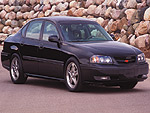
|
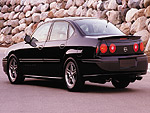
|
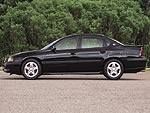 Classic Impala SS emblems adorn the
door panels below the beltline, while black-anodized
C-pillar trim keeps a low profile. The stance is right,
having been dropped an inch and a half.
Classic Impala SS emblems adorn the
door panels below the beltline, while black-anodized
C-pillar trim keeps a low profile. The stance is right,
having been dropped an inch and a half.
|
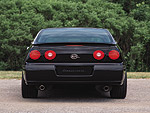 It's pretty much
the same story at the flank. There is a new SS spoiler and
body-color "taillamp applique." The fat BFGs and polished
exhaust tips only hint at the powerplant underhood.
It's pretty much
the same story at the flank. There is a new SS spoiler and
body-color "taillamp applique." The fat BFGs and polished
exhaust tips only hint at the powerplant underhood.
|
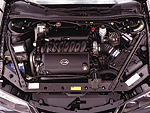 Here it is: The
LS1 engine fits the W-body platform so well, we have to
wonder if we will see a production vehicle in this
configuration in the not-too-distant future. Rumor has it
that smaller DOHC V8s could appear in FWD Pontiacs as early
as 2004.
Here it is: The
LS1 engine fits the W-body platform so well, we have to
wonder if we will see a production vehicle in this
configuration in the not-too-distant future. Rumor has it
that smaller DOHC V8s could appear in FWD Pontiacs as early
as 2004.
|
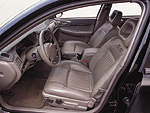 The interior is
pretty much standard issue Impala LS. There is a bit of
carbon fiber and some embroidery, but little else to
separate the SS from the ho-hum V6-ers.
The interior is
pretty much standard issue Impala LS. There is a bit of
carbon fiber and some embroidery, but little else to
separate the SS from the ho-hum V6-ers.
|
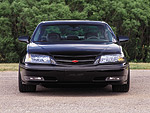 No superfluous
fluff here: Body embellishments were kept to a minimum. The
grille is modified with a "black expanded metal insert" and
a classic red bowtie. The front license plate cover is
customized with an embossed SS logo.
No superfluous
fluff here: Body embellishments were kept to a minimum. The
grille is modified with a "black expanded metal insert" and
a classic red bowtie. The front license plate cover is
customized with an embossed SS logo.
|
|
|
HHome
Run Hero
This
LS1-powered Impala SS could take the world by storm, if only it
gets the chance
By Chris
Endres
Photography: courtesy of GM
Big, bold and
brash. It is these three adjectives which best summarize the
Chevrolet Impala SS of the 1990s. Such glowing praise was an
abject about-face for a body style that had been universally
mocked since its introduction in 1991. So hideous and bulbous
was the re-skin of the venerable Caprice Classic that black and
white police versions were quickly dubbed Shamu. They were that
god-awful.
So to hear the
collective gasp (followed by a thunderous roar of approval) from
the automotive world when Jon Moss unveiled his Caprice-derived
Impala SS concept car in January 1993 was unexpected. Gone were
the strange triangular C-pillar windows, droopy rear wheelwell
openings and superfluous chrome. In were a striking C-pillar
redesign, big wheels and tires, gallons of black paint and, most
importantly, a powerful new engine. The Impala SS concept car
was such an overwhelming hit that GM fast-tracked it to
production, where it arrived as a 1994 model. Sporting 17-inch
aluminum wheels and a 260-horsepower iron-headed version of the
hot LT1 mill, it was a very capable performer.
The Impalas
built over that glorious three-year production run were not the
fastest or most luxurious or best handling cars of their time.
But they had that certain savoir faire that spoke to
enthusiasts. Chevy had truly turned lemons into lemonade. Alas,
the radiant Impy lasted just three model years, as its
Arlington, Texas assembly plant was re-tooled for truck
production. Essentially, they got it right and almost
immediately, unceremoniously killed it. Ladies and gentlemen, I
present to you the pitfalls of brand mismanagement.
Fast-forward a
handful of years to the re-introduction of the front-wheel drive
2000 Impala. In spite of its unmitigated sale success among the
general public, B-body loyalists howled in protest at the
emasculation of their once-proud four-hooved mammal. The new
Impala was the polar opposite of its forerunner. Small,
practical and underpowered had seemingly become the new
catchphrases for GM passenger cars, particularly where the
Impala was concerned. Let's face it: even the optional 200-horse
3800 V6 doesn't have the oats to push the 3,400-pound car to
inspire full-throttle awe. [It does, however, have the muscle to
out-accelerate, out-handle and out-brake Ford's full-sized Crown
Victoria, but we're also dealing with the popularly perceived
benefit of rear-wheel drive and V8 power.--Ed.]
It doesn't
take much imagination to picture our knee-jerk reaction to this
Impala SS nestled among the dreamy hot rods at the 2002 GM Toys
Test. "Gee-whiz," we thought, "someone must have really knocked
themselves out bolting lowering springs and new wheels to a
ho-hum Impy." Unimpressed, we sauntered over for a closer
inspection anyway. Boy, were we surprised to find an
honest-to-Pete LS1 nestled discretely between the shock towers!
Jon Moss had once again pulled the proverbial rabbit out of the
hat.
The Impy's
engine started as a production Corvette item that was modified
to fit in the chassis and work with the FWD running gear. The
rear face of the block was machined to accept an adapter plate
that meshes with the 4T65-E four-speed transaxle. The rear of
the crankshaft was then shaved 4mm and a one-off stainless steel
pilot bushing was created to allow torque converter
installation. The Corvette's gull wing oil pan was far too wide
for the installation, so a new structural aluminum pan was cast.
Likewise, the OEM water pump was another source of interference,
so a billet aluminum pump was carved out to perform the duty.
A stock intake
manifold with an F-body cable-actuated throttle body was
installed backwards, allowing the induction system to be placed
comfortably in the front driver's side corner of the engine
room. An airbox from a 3800-powered Monte Carlo was sliced and
diced in an attempt to provide sufficient airflow for the
voracious LS1. Though the right (rear) bank header is a custom
stainless piece, the left (front) bank is a production F-body
unit. Bottom side, they are mated by a custom y-pipe that leads
to stainless muffs and 2.75-inch tailpipes.
Besides the
fairly extensive cooling system mods, surprisingly few
additional mods were required. The engine runs on a tweaked
Gen-III Powertrain Control Module, while the fuel system is
standard-issue Impala.
Outwardly, the
SS was kept low key. A few low-profile emblems populate the
sheetmetal and keep pace with the subtle blackout theme. The
17-inch billet wheels add some flash while the BFGs try to keep
up with the torquey V8.
Back indoors,
there is standard LS-level leather buckets with some SS
embroidery and a bit of racy carbon fiber trim. Perhaps the most
interesting addition to the interior is the inclusion of a Monte
Carlo gauge cluster. This six-gauge transplant provides all
essential info to the driver, including a rev-counter whose
importance cannot be overstated for the rev-happy LS1. Nice
touch.
Front-wheel
drive V8 combinations are nothing new, even at GM. Oldsmobile
was shoehorning its 455-inch monstrosity in the FWD Toronado in
the mid-'60s. Newsflash for you: V8 power in FWD configuration
is just as outrageous an idea now as it was then. Torque-steer
and massive quantities of tire smoke might not appeal to some
bluehairs, but if driving the front wheels is the only choice,
we'll take it in spades. Besides, with modern power management
strategies, any negative downsides can be reduced and even
eliminated, thanks to our friend the computer. At any rate, the
first thing we'd do with a production LS1 Impala SS is disable
any anti-slip tomfoolery.
The bottom
line is that low-volume niche markets are where it's at. One
needs to look no further than the success of Corvette, Viper,
Lightning and even the re-born Thunderbird to see that
cookie-cutters are out, niche is in. We now know that GM has the
capability of turning out front-wheel drive LS1 cars, so why not
treat the Impala marque with the dignity it deserves? If you're
out there reading this, Mr. Moss, please, puh-leeez, figure out
a way to make it happen. Then the world can really see how
front-wheel drive performance should be done!
|
![]()